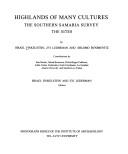| Listing 1 - 5 of 5 |
Sort by
|
Book
ISSN: 09470549 ISBN: 398075782X 9783980757829 Year: 2005 Publisher: Berlin Ex oriente
Abstract | Keywords | Export | Availability | Bookmark
 Loading...
Loading...Choose an application
- Reference Manager
- EndNote
- RefWorks (Direct export to RefWorks)
Axes, Prehistoric --- Stone implements --- Middle East --- Antiquities.

ISBN: 9654400073 Year: 1997 Publisher: Tel Aviv Tel Aviv University. Institute of archaeology
Abstract | Keywords | Export | Availability | Bookmark
 Loading...
Loading...Choose an application
- Reference Manager
- EndNote
- RefWorks (Direct export to RefWorks)
Excavations (Archaeology) --- Samaria (West Bank : Region) --- Antiquities.
Book
Year: 2021 Publisher: Tübingen Tübingen University Press
Abstract | Keywords | Export | Availability | Bookmark
 Loading...
Loading...Choose an application
- Reference Manager
- EndNote
- RefWorks (Direct export to RefWorks)
In recent decades, a significant number of Pleistocene (ca. 2.6 million years–10,000 years ago) open-air and cave sites yielding elephant or mammoth bones in direct association with hominin remains and/or lithic artifacts have been discovered in Eurasia, Africa and America. Many of them show strong evidence of acquisition and processing of proboscidean carcasses by early humans, leading scientists to interpret them as “elephant butchering sites”. Indeed, proboscidean exploitation by early Homo has been proposed to have been critical for Palaeolithic human lifeways, influencing not only their subsistence, but also other aspects of early human evolution and adaptations. The nature and degree of interactions between humans and elephants comprises an important field in palaeoanthropological studies since decades, but many questions remain still unanswered or partially explored. By bringing together research papers from the fields of Palaeolithic Archaeology, Palaeoanthropology, Palaeontology, Zooarchaeology, Geology, Ethnography and Nutrition Studies, the book systematically covers a diverse array of perspectives on elephant-human interactions across the world from the Pleistocene times until today. The volume includes 19 contributions and is organized into four thematic sections: 1) The Palaeolithic record, 2) A view of the evidence, 3) Elephants in past human nutrition, and 4) Ethnography – Human-elephant interactions in recent Africa. Collectively, the volume not only showcases the current state of knowledge, but also intends to provoke renewed interest for current and further research, and build an interdisciplinary and synthetic understanding of the significance of proboscideans throughout human evolution.
Prehistoric archaeology --- Elephants --- Mammoth --- Pleistocene --- Paleanthropology --- Paleontology --- Archaeozoology --- Ethnology
Book
Year: 2021 Publisher: Tübingen Tübingen University Press
Abstract | Keywords | Export | Availability | Bookmark
 Loading...
Loading...Choose an application
- Reference Manager
- EndNote
- RefWorks (Direct export to RefWorks)
In recent decades, a significant number of Pleistocene (ca. 2.6 million years–10,000 years ago) open-air and cave sites yielding elephant or mammoth bones in direct association with hominin remains and/or lithic artifacts have been discovered in Eurasia, Africa and America. Many of them show strong evidence of acquisition and processing of proboscidean carcasses by early humans, leading scientists to interpret them as “elephant butchering sites”. Indeed, proboscidean exploitation by early Homo has been proposed to have been critical for Palaeolithic human lifeways, influencing not only their subsistence, but also other aspects of early human evolution and adaptations. The nature and degree of interactions between humans and elephants comprises an important field in palaeoanthropological studies since decades, but many questions remain still unanswered or partially explored. By bringing together research papers from the fields of Palaeolithic Archaeology, Palaeoanthropology, Palaeontology, Zooarchaeology, Geology, Ethnography and Nutrition Studies, the book systematically covers a diverse array of perspectives on elephant-human interactions across the world from the Pleistocene times until today. The volume includes 19 contributions and is organized into four thematic sections: 1) The Palaeolithic record, 2) A view of the evidence, 3) Elephants in past human nutrition, and 4) Ethnography – Human-elephant interactions in recent Africa. Collectively, the volume not only showcases the current state of knowledge, but also intends to provoke renewed interest for current and further research, and build an interdisciplinary and synthetic understanding of the significance of proboscideans throughout human evolution.
Prehistoric archaeology --- Elephants --- Mammoth --- Pleistocene --- Paleanthropology --- Paleontology --- Archaeozoology --- Ethnology
Book
Year: 2021 Publisher: Tübingen Tübingen University Press
Abstract | Keywords | Export | Availability | Bookmark
 Loading...
Loading...Choose an application
- Reference Manager
- EndNote
- RefWorks (Direct export to RefWorks)
In recent decades, a significant number of Pleistocene (ca. 2.6 million years–10,000 years ago) open-air and cave sites yielding elephant or mammoth bones in direct association with hominin remains and/or lithic artifacts have been discovered in Eurasia, Africa and America. Many of them show strong evidence of acquisition and processing of proboscidean carcasses by early humans, leading scientists to interpret them as “elephant butchering sites”. Indeed, proboscidean exploitation by early Homo has been proposed to have been critical for Palaeolithic human lifeways, influencing not only their subsistence, but also other aspects of early human evolution and adaptations. The nature and degree of interactions between humans and elephants comprises an important field in palaeoanthropological studies since decades, but many questions remain still unanswered or partially explored. By bringing together research papers from the fields of Palaeolithic Archaeology, Palaeoanthropology, Palaeontology, Zooarchaeology, Geology, Ethnography and Nutrition Studies, the book systematically covers a diverse array of perspectives on elephant-human interactions across the world from the Pleistocene times until today. The volume includes 19 contributions and is organized into four thematic sections: 1) The Palaeolithic record, 2) A view of the evidence, 3) Elephants in past human nutrition, and 4) Ethnography – Human-elephant interactions in recent Africa. Collectively, the volume not only showcases the current state of knowledge, but also intends to provoke renewed interest for current and further research, and build an interdisciplinary and synthetic understanding of the significance of proboscideans throughout human evolution.
Elephants --- Mammoth --- Pleistocene --- Paleanthropology --- Paleontology --- Archaeozoology --- Ethnology
| Listing 1 - 5 of 5 |
Sort by
|

 Search
Search Feedback
Feedback About
About Help
Help News
News